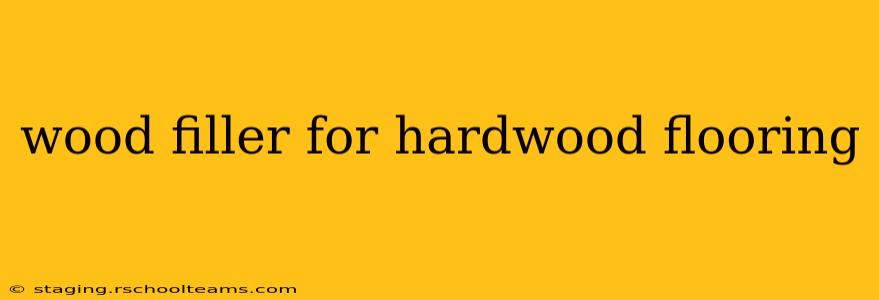Hardwood floors are a beautiful and valuable asset to any home, but even the most durable wood can suffer scratches, dents, and gaps over time. Fortunately, wood filler can effectively repair these imperfections, restoring the beauty and integrity of your flooring. Choosing the right filler, however, is crucial for a seamless and long-lasting repair. This guide will walk you through everything you need to know about selecting and using wood filler for your hardwood floors.
What are the Different Types of Wood Filler?
Several types of wood filler are available, each with its strengths and weaknesses. Understanding these differences is key to selecting the best option for your specific needs.
-
Solvent-Based Wood Filler: This type of filler is known for its durability and shrinkage resistance. It's often preferred for larger repairs and areas that experience significant wear and tear. However, it requires more preparation and cleanup due to its solvent base.
-
Water-Based Wood Filler: This eco-friendly option is easier to clean up and often has less odor. While suitable for many repairs, it may not be as durable as solvent-based fillers, especially in high-traffic areas.
-
Epoxy Wood Filler: Epoxy fillers are incredibly strong and are excellent for filling deep gouges and cracks. Their superior adhesion makes them ideal for repairs that require extra strength and durability. They're also a good choice for exterior wood applications, although they are generally not needed for interior hardwood floors.
-
Paste Wood Filler: This type of filler is often pre-colored and comes in a paste-like consistency. It's easy to apply and is perfect for small scratches and minor imperfections. However, it may not be suitable for larger repairs.
How to Choose the Right Color Wood Filler?
Matching the color of your wood filler is paramount for an invisible repair. Here are some helpful tips:
-
Test in an inconspicuous area: Before applying the filler to the damaged area, test it on a less visible part of the floor to ensure a perfect color match.
-
Consider the wood's finish: The finish on your hardwood will impact the final appearance of the filler. Consider using a filler that is slightly darker than your wood to avoid it appearing too light after the finish is applied.
-
Mix colors: If you can't find an exact match, you can often mix different colors of filler to achieve a closer approximation.
What are the Best Wood Fillers for Hardwood Floors?
There isn't a single "best" wood filler, as the optimal choice depends on the specific repair and your personal preferences. However, several highly-rated options consistently receive positive reviews for their performance on hardwood floors. Research specific brands and products to find one that aligns with your needs.
How to Repair Scratches and Gouges in Hardwood Floors Using Wood Filler?
Repairing damage with wood filler involves several key steps:
-
Clean the area: Remove any dirt, debris, or loose wood fibers from the damaged area.
-
Apply the filler: Use a putty knife or similar tool to apply the filler, pressing it firmly into the scratch or gouge. Remove any excess filler.
-
Let it dry: Allow the filler to dry completely according to the manufacturer's instructions. This is crucial for a successful repair.
-
Sand the area: Once dry, use fine-grit sandpaper to smooth the filler flush with the surrounding wood.
-
Apply finish: If necessary, apply a new coat of finish to match the existing finish on your floor.
Can You Use Wood Filler on Gaps in Hardwood Flooring?
Yes, wood filler can be used to fill small gaps between hardwood planks. However, for larger gaps, it is usually best to use a specialized wood floor gap filler rather than standard wood filler. Larger gaps often indicate more significant structural issues that may require the attention of a professional.
How Long Does Wood Filler Take to Dry?
Drying time varies depending on the type of wood filler, the size of the repair, and environmental conditions. Always refer to the manufacturer's instructions for drying time. Generally, it can take anywhere from a few hours to several days.
What Happens if the Wood Filler Doesn't Match the Floor?
If the wood filler doesn't perfectly match the floor, the repair will be visible. While a close match is ideal, sometimes a slightly off color is less noticeable than a poorly executed repair. The best approach is to test a small, hidden area before attempting a full repair.
Can I use wood glue instead of wood filler?
Wood glue is primarily used for bonding pieces of wood together; it’s not meant to fill gaps or blemishes. Wood filler is designed for filling, allowing for a smooth, finished surface after sanding and finishing.
This comprehensive guide provides you with the information you need to successfully repair your hardwood floors. Remember to always follow the manufacturer's instructions for your chosen wood filler, and if you're unsure about any aspect of the repair process, it's always best to consult with a professional.
